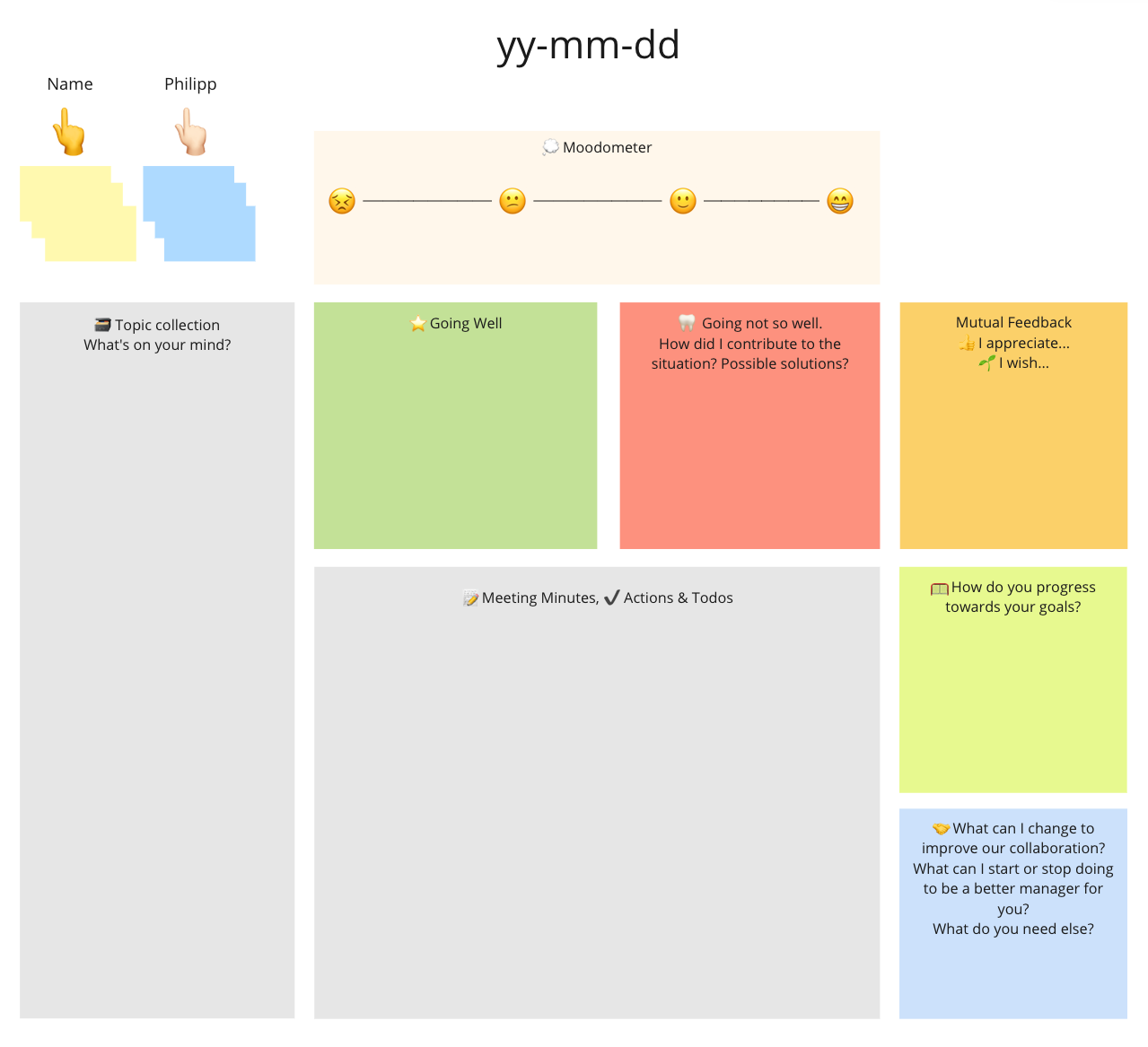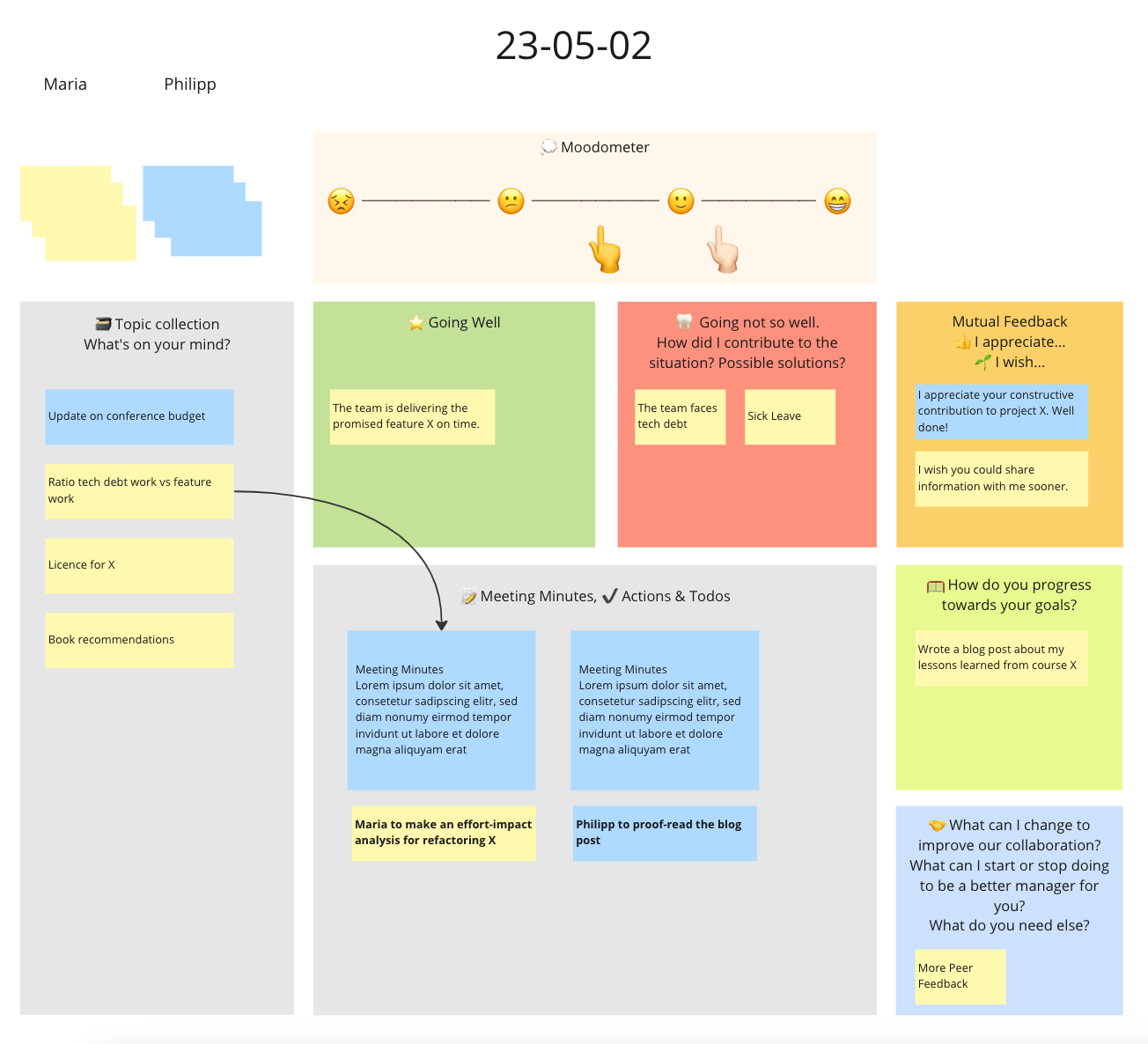Template for Efficient One-On-One Meetings
Posted on Feb 7, 2023. Updated on Aug 1, 2023
One-on-Ones are one of the most important and powerful tools for leaders. If done well, they can help you to spot issues before they escalate, unblock, establish trust, foster a culture of mutual feedback, and ensure the growth of all participants. This post provides a template incorporating the principles for great one-on-ones to achieve this more easily.
TL;DR

My template for one-on-one meetings
Principles of Great One-On-Ones
Before we jump into the one-on-one structure, let’s recap the principles of great one-on-one meetings:
- Shared running record. Having a record of your one-on-one that both can access is crucial. Moreover, it must be running, which means it contains the historical record of all past one-on-ones.
- Frequent. The frequency depends on how much you are involved with your people in the operational work. If you work closely together with them daily, 30 min/2 weeks might be enough. If not, I recommend 30 min - 1h weekly. Then in doubt, start with a high frequency and adjust afterward.
- Mutual Feedback.
- In general, feedback should be delivered timely. At least in the next one-on-one. That’s why it’s important to make feedback exchange a pillar of each one-on-one.
- Ask for feedback for yourself and how you can become a better manager for them. That is crucial to establish a culture of continuous feedback and open everyone up for feedback that you give. It also shows a growth mindset and trust.
- It’s their meeting. Make it clear that this is their meeting, and you listen to them. In the meeting, you should noticeably talk less than your people. Moreover, it’s essential that they bring their topics to the meeting.
- Transparency. Both participants should add topics before the meeting to the record so there is no surprise and everyone can prepare.
- Action Items. Define clear action items and assignees.
- Goals Follow-up. Keep their goals on top of their head.
To implement those principles, I created a one-on-one template that helps to put them into practice, be more efficient, and don’t forget any aspect.
The One-On-One Template

The one-on-one template in action
💭 Moodometer
I start each one-on-one with the question “How are you feeling?” and ask them to rank their mood by putting the finger emoji on the scale from “very bad” to “very happy”. This way, they have to be more specific than just “I’m good/not good”.
Usually, my follow-up question is “How come?” (not: “why?") or “What would get it to the next emoji?”, and we start a conversation.
I also put my emoji on the scale.
🗃️ Topic Collection
I’m telling my people that the one-on-one is their meeting, and I’m here to listen to them and support them. Hence, I ask them to bring their topics to the meeting. That is the fuel that drives the one-on-one.
That’s why I ask them to add their thoughts and topics to the canvas before the meeting. I do the same for my topics. This is about transparency and that everyone knows what will come and can prepare (rule of no surprise).
When the meeting starts, we see today’s full agenda, which is important to manage time better. Then, we start talking about one topic after another.
📝 Meeting Minutes and ✔️ Action Items
While we talk, we take notes in the canvas “Meeting Minutes and Action Items”. This way, we ensure that we have a common understanding of what has been said. It’s also useful to remember the last one-on-one’s topics so we can follow up.
Moreover, we define action items. Each action item is marked bold and has a clear assignee.
⭐️ Going Well
I like to know what is going well. This is optional, and there is not every time something to talk about here. Still, I like to have this on the canvas, so we also take a moment to appreciate the great things.
🦷 Going Not so Well
But I also like to know what could be better. This is important as it gives the opportunity to learn and improve and support each other.
I also added the follow-up questions “How did I contribute to the situation?” and “What are the possible solutions?” to pivot the thinking from the problem towards the future, proactivity, self-efficacy, and possible solutions. Also, I like to discuss the learnings and what they can do to ensure that this problem will not come up again.
This is where coaching happens. I don’t push solutions (most of the time, I don’t have them either), but we brainstorm solutions together, and I try to ask questions to keep the “thinking bubble” over their head.
👍 🌱 Mutual Feedback
It’s crucial to establish a culture of continuous mutual feedback. That’s why this canvas is a fixed agenda point in our one-on-ones, so we remind ourselves to think and discuss feedback for each other.
I put the beginnings “I appreciate…” and “I wish… " to help us to phrase the feedback. Especially the phrasing “I wish…” helps to point corrective feedback toward the future and the desired behavior.
The feedback must be mutual:
My Feedback for Them
- Feedback should be timely. You should never wait for the next annual feedback session to deliver your feedback. So every time I see somebody doing great, I put a note on the canvas, and we talk about it in our next one-on-one. The same is true for corrective feedback.
- This approach has the advantage that we create a track record of the feedback. Then it comes to the half-yearly growth sessions, we can easily compile the feedback by going through the record of our past one-on-ones. Moreover, the feedback will be no surprise for them as they have heard it is already a past one-on-one.
Their Feedback for Me
- As a manager, you should go first. If you demonstrate that you want and can take constructive feedback, your people will be more likely to be open to the corrective feedback you give them.
- They might not come up with feedback the first time. But be persistent in asking them for feedback for you. This way, they know it will come every time, train their feedback muscles, and can prepare feedback for the next time.
- And last but not least, it shows trust and a growth mindset.
🥅 Progress Towards Goals
I conduct half-yearly growth conversations where we reflect on the last months, cover peer feedback, and define goals. But those goals are worthless if we don’t follow up on them and don’t track their progress. That is why I created a dedicated canvas, so we don’t forget to talk about their goals and progress. This way, we keep them at the top of our heads.
🤝 Collaboration and Become a Better Manager for Them
There are a couple of questions that are important to me, and I want to make sure I ask them from time to time and don’t forget it:
- What can I change to improve our collaboration?
- What can I start or stop doing to be a better manager for you?
- What do you need else?
I rotate these questions. It’s surprising what comes up when you ask them. Again, this is about fostering a culture of mutual open feedback and demonstrating that I want constructive feedback.
When it comes to feedback, it’s important to ask open specific questions (“What can I start or stop doing to be a better manager for you?") instead of closed vague questions (“Do you have feedback for me?") that give them an easy way out by saying “No”. You can even follow up with, “So everything is perfect?”.
Tools
I’m a fan of Miro and visualizations in general. That’s why I use Miro for my one-on-one record. It’s also easy to duplicate the template just by pressing Cmd + D. But you can use any other collaborative whiteboard tool to create a template on your own.
You can also use a classical document like Google Docs or Microsoft Word (the browser variant). I have used documents for many years (and still use them for the half-yearly growth session), and many of my colleagues are using them successfully.
It’s not so much about the tool, it’s about the structure of the one-on-ones. Every tool can be used as long as you can collaboratively edit the record.